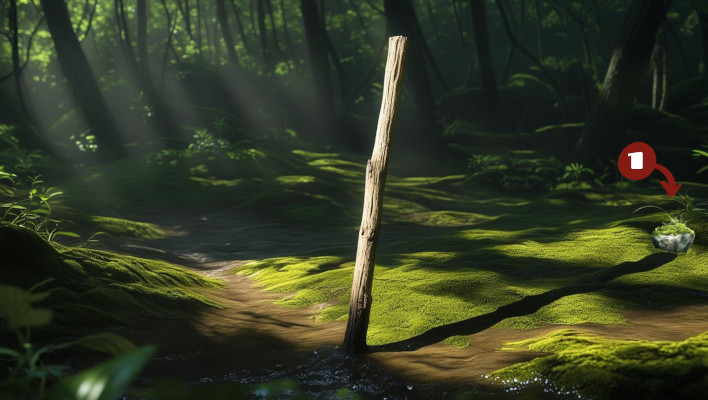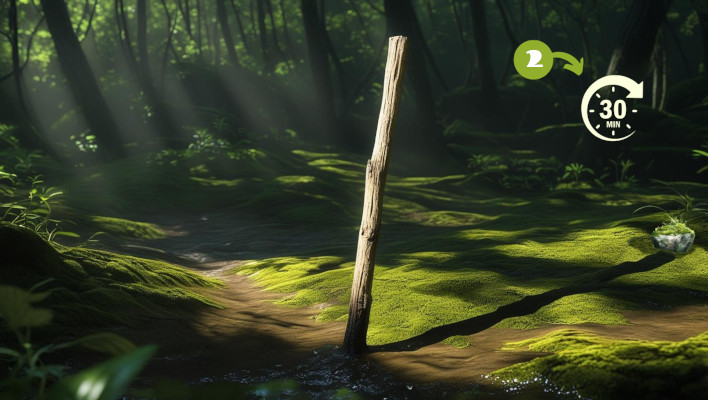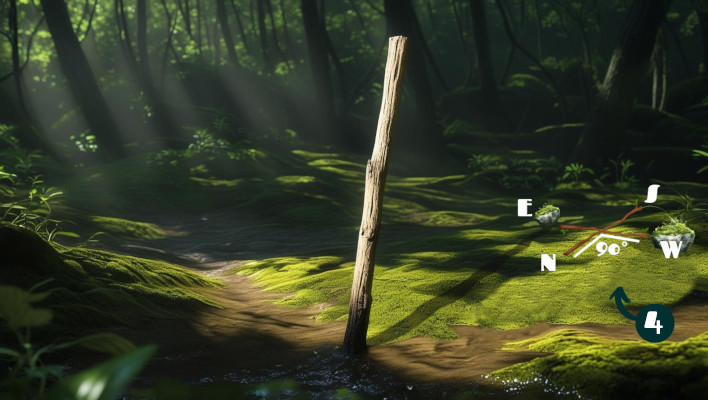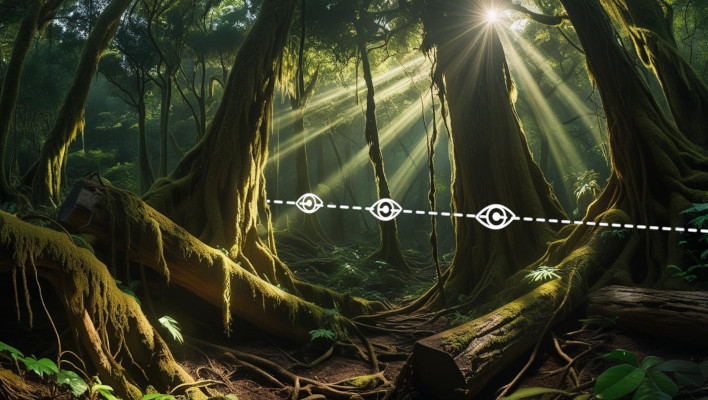Outdoor Survival & Navigation
When Clementine & Kiwi find themselves travelling alone in the Pangian forest, they’re not exactly prepared. With the help of Po, Wek, and Rea, a lot of hard work, and a ton of luck, they end up learning how to survive in the wilderness. What’s real? And, more importantly, how can you learn to do it too?
“Alright, Cheat One is figuring out directions. Grab a stick, and find a spot where the sun reaches the forest floor.” He hopped up and did just that. “Stick it upright in the ground, then place a rock at the tip of the shadow it casts, like so. Now we wait. Thirty minutes should do the trick.”
…
“Now the shadow has moved,” Po said, returning to his lesson. “We place a rock at the end of the new shadow. If we draw a line between the two, the first rock is west, and the second is east, more or less. Now, we draw a perpendicular line through the first, forming a cross, and the second line becomes north and south. So if you want to go northwest, you need to be heading that way. Eventually, you’ll be able to track the shadow movement of the trees, and you won’t need a stick.”

Shadow Stick Method Step 1:
Insert a straight stick into the forest floor. Place a rock at the end of the shadow it casts. This is roughly west.

Shadow Stick Method Step 2:
Wait 20-30 minutes.

Shadow Stick Method Step 3:
After 20-30 minutes, the shadow will have moved. Place a rock at the end of the new shadow. This is roughly east.

Shadow Stick Method Step 4:
Place a stick between the first and second rock. This represents west → east. Place a second stick perpendicular (at a 90° angle) to the first. This represents north → south.
The Shadow Stick Navigation Method
What Po calls “Cheat One” is known as the Shadow Stick Navigation Method, and it’s not a new concept! Humans (and Winged and Wingless!) have been using the movement of the sun and shadow to wayfind since the beginning of time.
The shadow stick method is a super easy and reliable way to find the cardinal directions (north, east, south, and west) without a compass. Like Po says, all you need to do is:
- Place a stick upright in the ground and mark the tip of the stick’s shadow with a rock (or stick, or hole). This mark will be west.
- Wait 20–30 minutes.
- Mark the tip of the new shadow with another rock. This mark will be east.
- Draw a line or place a stick between the two marks. This line runs West (first rock) → East (second rock). Place a second line or stick directly across the first one so that it makes a cross (perpendicular). This line will be North → South.
Things to keep in mind:
- Accuracy is best around midday, when shadows are shorter and easier to measure.
- The method works best around the spring and fall equinoxes, when the sun’s path is more balanced.
- It won’t work at night or on cloudy days.
Even though it isn’t perfect, the Shadow Stick is one of the simplest and most dependable natural navigation methods. While it won’t replace a compass or GPS, it’s far better than having no reference at all!

“That’s Cheat Two.” Po winked. “Once you have a direction, you want to pick a feature, like a tree or a boulder, in line with the direction you want to go. Walk to it and then pick another feature a ways ahead and walk to that. Make sure your features line up behind you and ahead of you as far as you can see. If you get disoriented or think you’re veering off course, go back to Cheat One and reorient yourself. It’s that easy.
Walking in a Straight Line
When Clem and Kiwi get lost, they find themselves walking around in circles. Studies have shown that without clear reference points, our stride length, leg strength, and even tiny subconscious choices can pull us off course (Science Daily, 2009). Over time, those small deviations add up, and before long, you may find yourself right back where you started!
Po’s “Cheat Two” is a known way to counteract this:
- Pick a prominent feature, like a tree or boulder, that is directly in line with the direction you want to go.
- Walk towards it. As you are walking, line up another feature directly in line with the first feature.
- As you walk, continue to make sure the features line up behind and ahead of you for as far as you can see.
- If you think you are veering off course, stop and re-orient yourself.
This works because you’re creating a series of fixed reference points that force you to move in a straight path, rather than letting your body’s natural biases cause you to drift. It’s essentially using the landscape as stepping stones to guide your sense of direction.
Things to keep in mind:
- Choose objects that stand out and won’t blend into the background as you move.
- The farther apart your markers, the straighter your path (but make sure they’re still visible!)
- Things like dense forests or uneven ground may force you off course. If you have to detour, realign yourself with your markers before continuing.
This method should not replace a GPS or map and compass, but it can help you maintain direction when you need it most!
WHAT CLEM & KIWI DID WRONG
In school, Clem was taught to stay put if lost—but Kiwi thinks this is a terrible idea. She knows they’re supposed to keep moving, and she wants to impress her dad by being where she’s supposed to be. Ultimately, they end up trying to find the bridge on their own. The impulse to walk yourself out when lost, while understandable, can make the situation much worse.
Without clear reference points, you can easily end up walking in circles, which makes the search area bigger and harder for rescuers to cover. Moving around when disoriented can also leave you exhausted, dehydrated, injured, or even lead you into more dangerous terrain.
What should you do instead? Clem was right, staying put is usually the best option. The U.S. Forest Service recommends you S.T.O.P.:
STOP. Stay put and stay calm.
THINK. How did you get there? What should you be seeing?
OBSERVE. Look for landmarks or anything familiar. Use a GPS or compass if you have one to try and orient yourself.
PLAN. Carefully consider your options. If it’s late, you are injured, or you aren’t confident—stay put.
For more details and self-rescue tips, check out the U.S. Forest Service.
KNOW BEFORE YOU GO.
Before heading out on any adventure:
PLAN. Research your route, terrain, trail conditions, and weather. BUDDY UP. Adventuring with a friend, family, or group isn’t just more fun; it also gives you a safety net, a morale boost, and increases visibility. DRESS FOR IT. Wear clothing and footwear suited to the terrain and weather. PACK FOR ADVENTURE. Food, water, extra warmth layers, rain gear, fire starter, headlamp, and a basic first-aid kit. POWER UP. Ensure phones, GPS devices, and headlamps are fully charged. Carry a power bank, charger cable, and/or spare batteries. TELL SOMEONE. Always leave a detailed itinerary with a friend or family member — include your route, start and end times, and your expected return time. NAVIGATION. Bring a GPS device, offline or paper maps, and/or a compass (and know how to use them!) KNOW YOUR LIMITS. Choose routes and distances that match your experience and fitness level. HAVE AN EMERGENCY PLAN. Pack a SPOT, Zoleo, or GPS tracking device in case of emergency (and a first aid kit!). Know how/who to call for help if something goes wrong. Review basic survival skills before heading out.Leave No Trace
Exploring the outdoors can be a ton of fun (or in Clem’s case, totally Type 2 fun!), but it’s important to remember that every step we take in the wilderness leaves an impact. To keep nature as wild and untouched as possible for future generations to enjoy, we need to tread lightly. Leave No Trace principles are a set of seven easy-to-follow outdoor ethics that help protect the environment so others can enjoy it too.
1. PLAN AHEAD & PREPARE. Research your route, pack the right gear, and know the rules.
2. TRAVEL & CAMP ON DURABLE SURFACES. Stick to trails, rocks, gravel, or dry grass to avoid damaging plants.
3. PROPERLY DISPOSE OF WASTE. Pack it in, pack it out — including food scraps and toilet paper.
4. LEAVE WHAT YOU FIND. Don’t take rocks, flowers, or artifacts; leave nature as it is. Avoid stacking rocks, tagging or defacing cliffs, or carving your name in trees.
5. MINIMIZE CAMPFIRE IMPACT. Use a camp stove when possible. Keep campfires small and use established rings. Always make sure your fire is dead out.
6. RESPECT WILDLIFE. Observe animals from a distance and never feed them.
7. BE CONSIDERATE OF OTHERS. Keep noise down, yield on trails, and share the outdoors respectfully.
Being good adventurers means being good caretakers, too. And forest stewards, like Wek & Rea, will thank you!
RESOURCES
Fun Resources For Outdoor Learning
OUTDOOR SURVIVAL & NAVIGATION
U.S. Forest Service: If You Get Lost A thorough explanation of the S.T.O.P. method and practical tips for self-rescue. REI: How to Use a Compass A complete guide to compass use, including compass anatomy, map orientation, taking bearings, and a “how-to” video for visual learners. Institute of Navigation Ten navigation educational lessons developed by ION to introduce navigation into middle school curricula. Each lesson is available as a downloadable .pdf. Adventure Smart A national prevention program for Canadians and visitors participating in outdoor recreational activities. Site offers free courses, survival guides, games, and tips for adventurers of all ages.GET OUTSIDE!
DiscovertheForest.org This program aims to inspire parents and tweens to experience the outdoors together. Website contains a robust selection of educational materials and games that inspire real-world learning. Project Learning Tree Committed to advancing environmental education, PLT offers award-winning activities and resources (PreK-12) that engage children in learning about the environment. Tree and forestry focused. Earth Rangers A youth-friendly environmental charity empowering kids to become environmental leaders. App-based activities and missions get youth taking real action. As well as teacher resources, programs, podcasts, and more.LEAVE NO TRACE
Leave No Trace Canada Leave No Trace Canada is a non-profit dedicated to promoting LNT principles to protect Canada’s natural and cultural heritage while enjoying the great outdoors. They offer fun and informative training videos to learn LNT principles and other helpful resources. LeaveNoTrace.org A non-profit using science-based education to inspire responsible recreation. The website offers online courses, great tips on applying LNT principles, science & research facts, and practical ways to implement LNT principles into your next adventure.DISCLAIMER
The outdoor skills and navigation methods described here are for educational purposes only. They are not a substitute for professional training or supervised practice. Being in nature is inherently risky, and you should never venture out without proper preparation, equipment, and knowledge of your surroundings. Always put safety first, be prepared for changing conditions, and seek proper instruction before heading into the wilderness. We are not responsible for accidents, injuries, misuse of this information, or the content of any third-party links provided.
